Head of the fauna section: Dmitry Viktorovich Malakhov
Implementation period: 2023–2025
IRN: BR21882122
ABOUT THE PROJECT:
The main executor of the project is Al-Farabi Kazakh National University. The “Institute of Zoology” of the Science Committee of the Ministry of Science and Higher Education of the Republic of Kazakhstan and the “Institute of Botany and Phytointroduction” of the Forestry and Wildlife Committee of the Ministry of Ecology and Natural Resources are responsible for assessing the state of biodiversity within the project framework.
Among the four regions of Western Kazakhstan, the fauna of the Mangystau region is the least studied and, at the same time, the most interesting scientifically. In its southern part, there is a transition zone from the Kazakh fauna to the Turanian and southern desert faunas. The area hosts desert species such as the sand hare and cheetah, as well as representatives of the Iranian–Afghan fauna like the long-eared hedgehog and red-tailed jird. There are also rare and unconfirmed records of the honey badger (Mellivora capensis), striped hyena (Hyaena hyaena), leopard (Panthera pardus), raccoon dog (Nyctereutes procyonoides), and Indian porcupine (Hystrix leucura). The northern parts of the study area, where steppe and forest-steppe elements of fauna and flora occur, are also of great interest and require further detailed field surveys. These territories are important from a biogeographical and zoogeographical perspective, as they help clarify the range boundaries of individual species and the processes of intergradation.
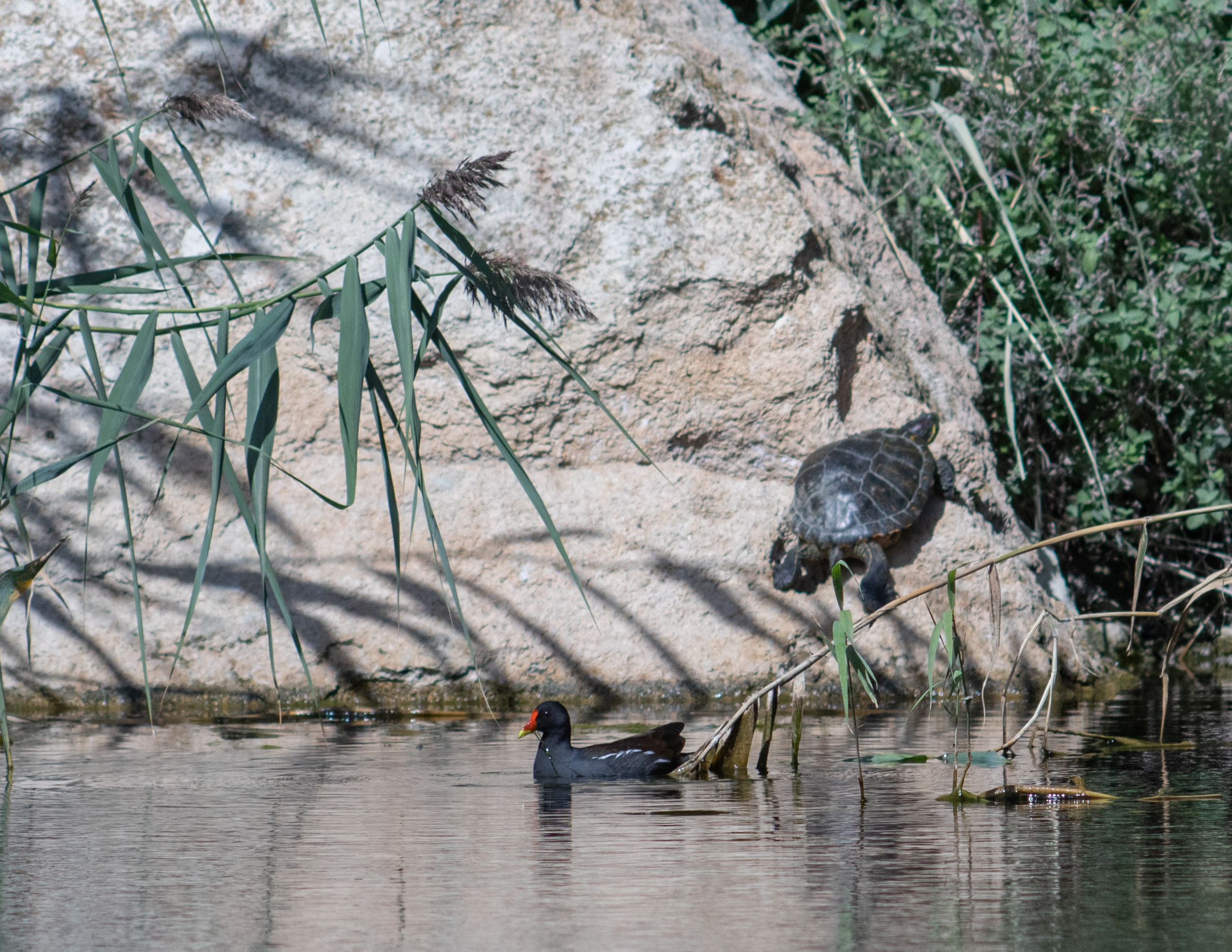
Relevance
The study, conservation, and rational use of biodiversity are of particular relevance due to ongoing climate change and growing anthropogenic pressure on ecosystems. Kazakhstan’s ratification of the Convention on Biological Diversity in 1994 imposes obligations to preserve genetic, species, and ecosystem diversity. The study and protection of biological diversity remain among the key priorities of modern biology and ecology. Solving these challenges requires the collaboration of scientific institutions and experts from various disciplines.
Goal: to conduct a comprehensive assessment of the state of biodiversity in the project area, evaluate potential changes caused by climate impacts, and develop regional action plans for the conservation of rare and endangered animal species.
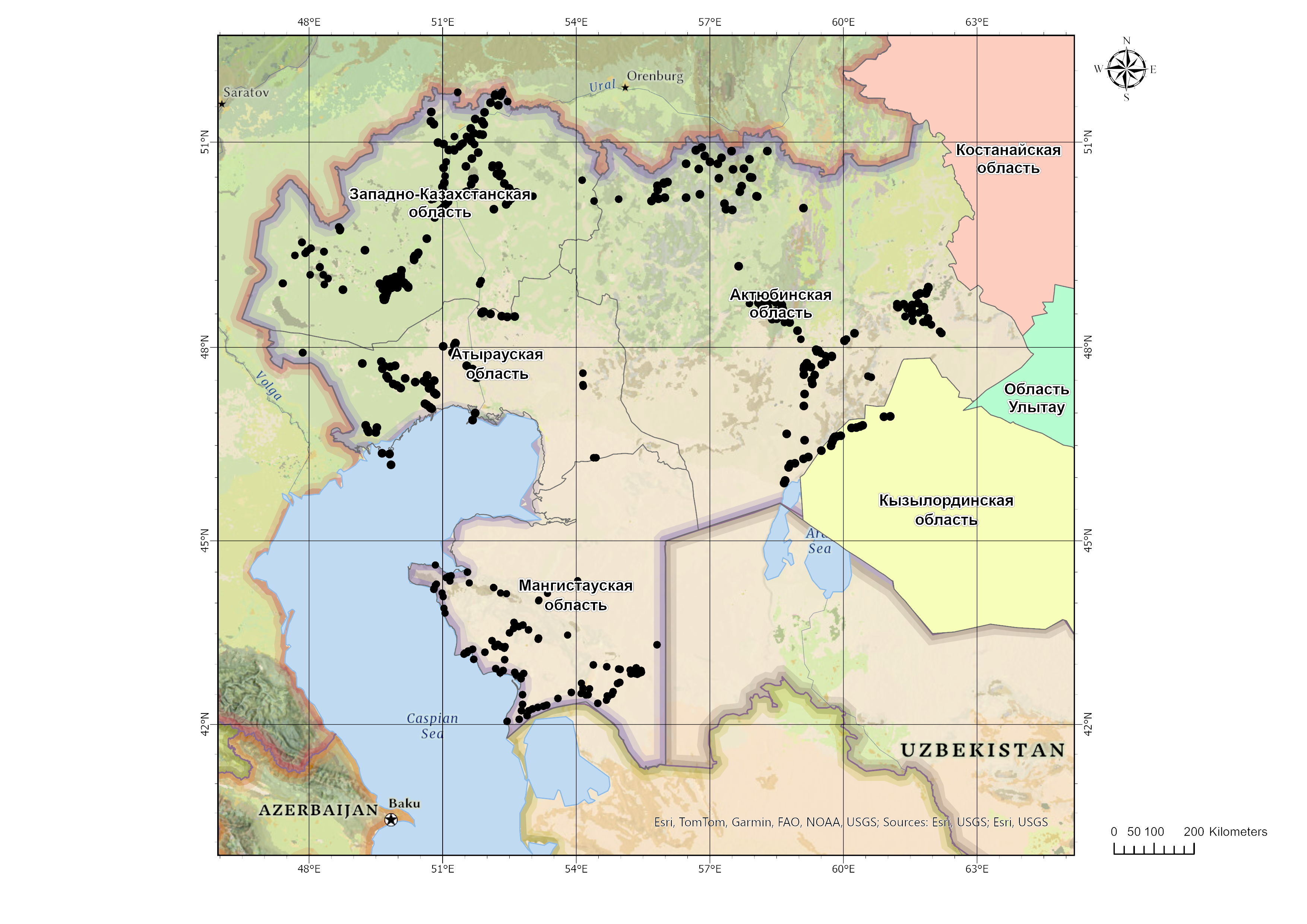
Main objectives
- Assess the current state of biodiversity in the project area
- Carry out an inventory of biodiversity objects and create a series of information-analytical maps
- Develop regional action plans for the conservation of rare and endangered species of animals and plants
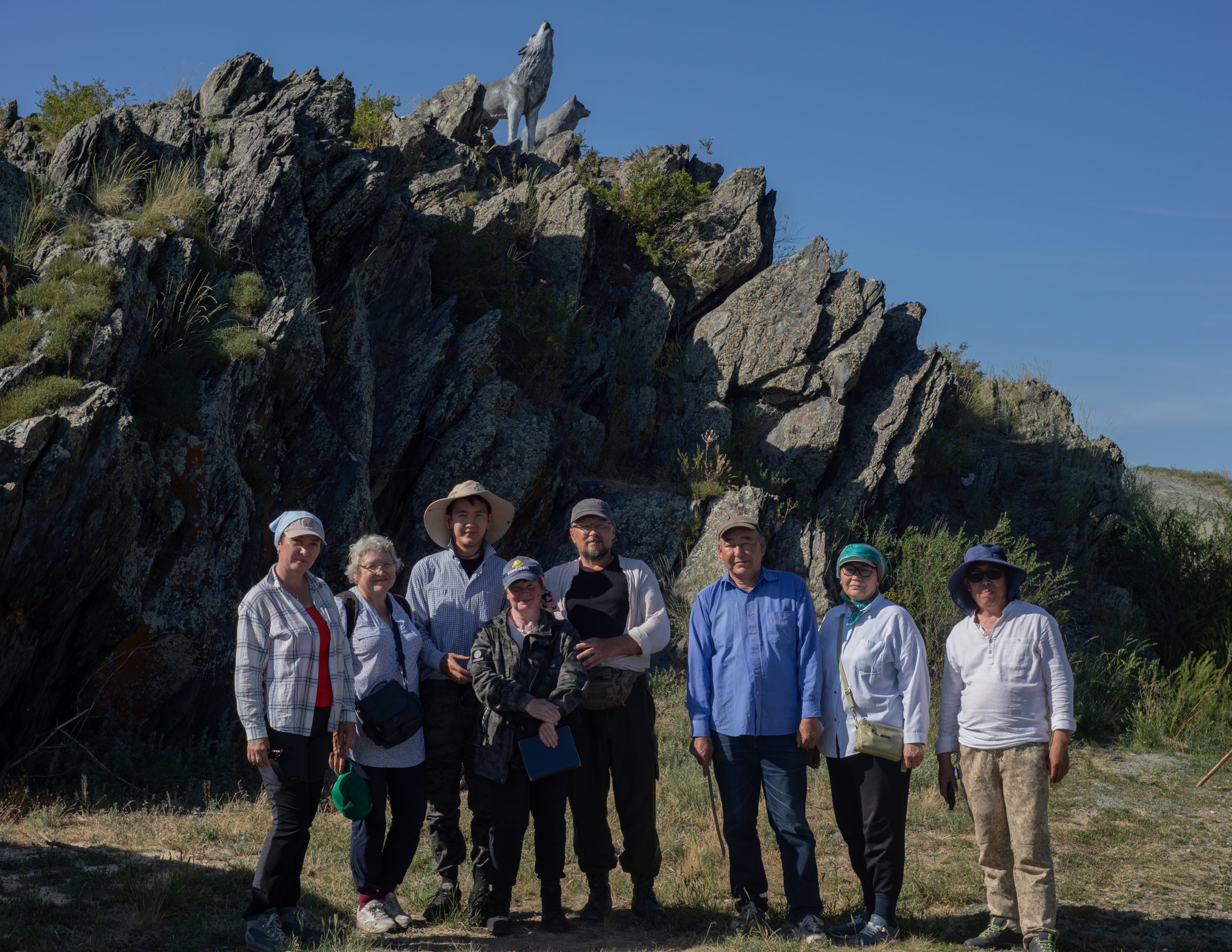
Photo: D.V. Malakhov
PROJECT PARTICIPANTS
Dmitry Viktorovich Malakhov – project scientific supervisor, head of the GIS and Remote Sensing Center. ORCID ID: 0000-0002-7844-6569, h-index 7
Research team:
1. Rustem Khasenovich Kadyrbekov – D.Sc. (Biology), leading researcher of the Laboratory of Entomology, ORCID ID: 0000-0003-0550-3697, h-index 2
2. Tatyana Nikolaevna Duisebaeva – Ph.D. (Biology), senior researcher of the Laboratory of Ornithology and Herpetology, ORCID ID: 0000-0002-0127-3604, h-index 9
3. Sergey Vasilievich Titov – Sc.D., senior researcher of the Laboratory of Entomology, ORCID ID: 0000-0003-2196-280X, h-index 3
4. Ivan Olegovich Nekhaev – Ph.D. (Biology), senior researcher of the Laboratory of Arachnology and Other Invertebrates, ORCID ID: 0000-0002-9464-715X, h-index 9
5. Boris Vasilievich Zlatanov – Ph.D. (Biology), senior researcher of the Laboratory of Entomology, ORCID ID: 0000-0002-2858-5595
6. Aizhan Myltikbaevna Tleppaeva – Ph.D. (Biology), senior researcher of the Laboratory of Entomology, ORCID ID: 0000-0002-9754-2177
7. Anna Alexandrovna Nekhaeva – Ph.D. (Biology), senior researcher of the Laboratory of Arachnology and Other Invertebrates, ORCID ID: 0000-0002-4972-2122, h-index 4
8. Alexander Sergeevich Linnik – M.Sc. (Biology), researcher of the Center for Biocenology and Wildlife Management, ORCID ID: 0000-0003-4472-2307, h-index 0
9. Ivan Gennadievich Frolov – researcher of the Laboratory of Ornithology and Herpetology, ORCID ID: 0000-0002-7907-9166, h-index 1
10. Olga Vladimirovna Dolbnya – M.Sc. (Engineering), researcher of the GIS and Remote Sensing Center, ORCID ID: 0000-0001-9728-5564, h-index 0
11. Anna Mikhailovna Khamchukova – M.Sc., researcher of the Center for Biocenology and Wildlife Management, ORCID ID: 0000-0002-6301-1810, h-index 0
12. Leonid Viktorovich Kim – M.Sc. (Biology), junior researcher of the Laboratory of Arachnology and Other Invertebrates, ORCID ID: 0000-0003-1916-7639, h-index 0
13. Zh.S. Abdullaev – junior researcher of the Laboratory of Theriology.
Tripartite cooperation agreements were signed with ACBK (Association for the Conservation of Biodiversity of Kazakhstan), the Scientific and Production Center of Fisheries LLP, and the State Nature Reserve “Bokeyorda”.
PROJECT RESULTS:
Summary of 2024 results
- A comprehensive study of the fauna of the Western Kazakhstan region was conducted. A large volume of archival materials (publications, collection catalogs, online resources) on biodiversity within the project area was analyzed.
- Analysis of quantitative parameters of marine invertebrates was initiated. Freshwater mollusks were collected in Atyrau and Mangystau regions.
- Data on arachnids across four regions — West Kazakhstan, Mangystau, Aktobe, and Atyrau — were collected and systematized. Information on insect diversity was mainly compiled from archival and literary sources.
- An inventory of the current taxonomic composition of ichthyofauna in the Western Kazakhstan region identified 101 fish species belonging to 23 families and 13 orders.
- Herpetological research was carried out in the Mangystau and Aktobe regions, while data on the West Kazakhstan and Atyrau regions were obtained from archival and published sources.
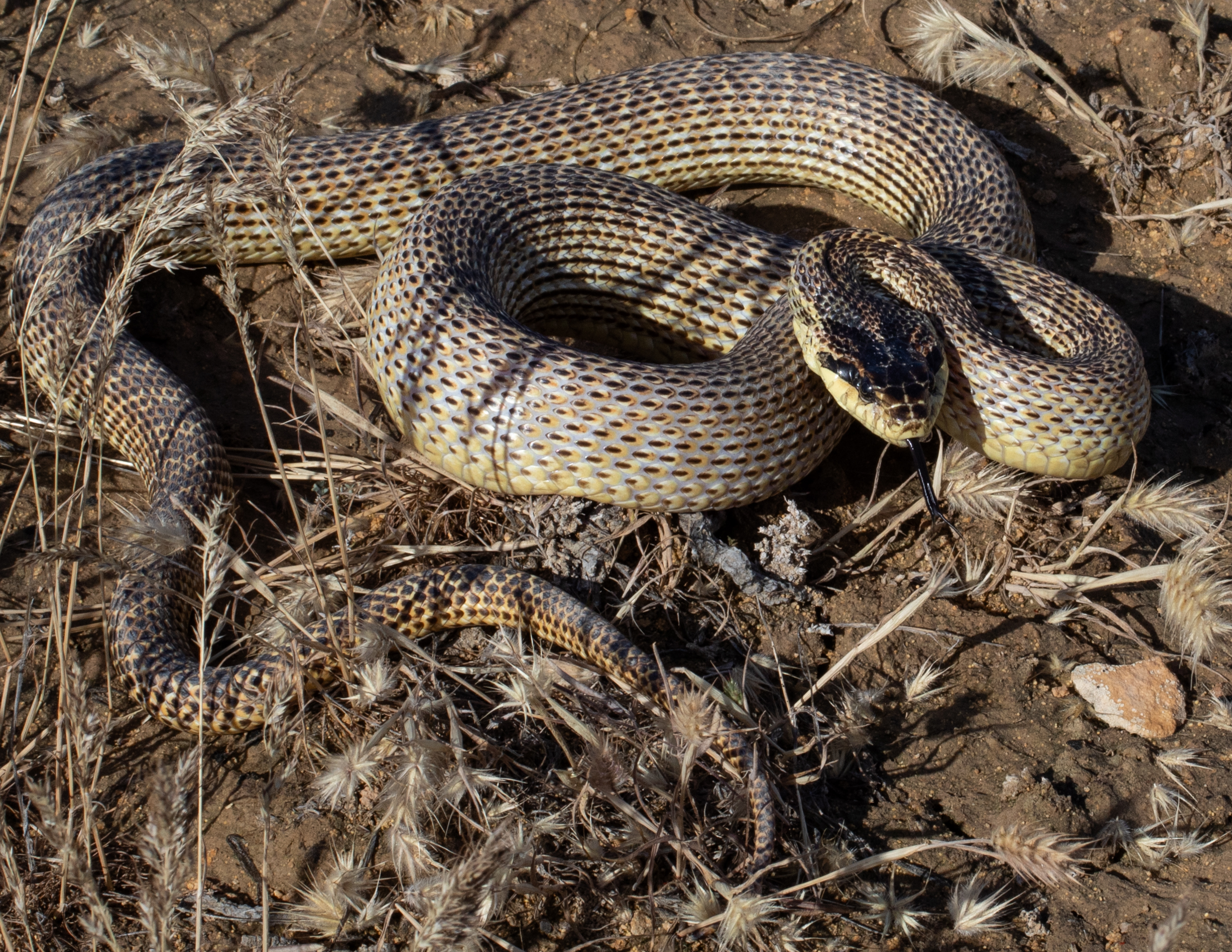
Photo: D.V. Malakhov
- Field observations of avifauna were conducted in the Mangystau, Atyrau, and Aktobe regions.
- Field data on the mammalian fauna were collected throughout the project area.
- Based on the obtained maps of species diversity for individual taxa, an integrated biodiversity map was produced.
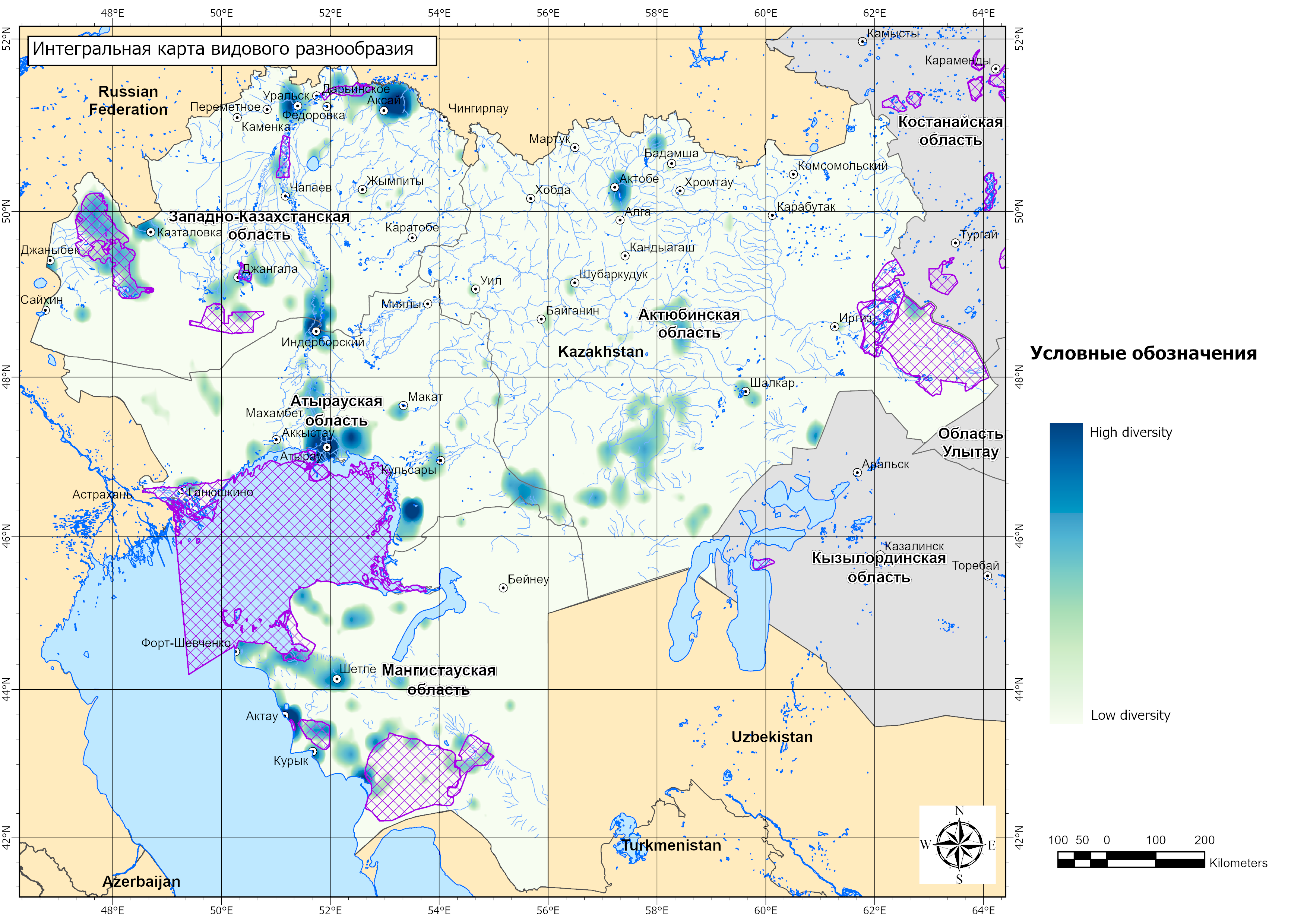
Purple shading indicates protected areas.
- Risk assessment and identification of vulnerable areas were carried out for key studied groups. Recommendations were formulated to preserve the current state of biodiversity for each group. A preliminary list of risk factors was established for subsequent indexing and use in predictive modeling.
